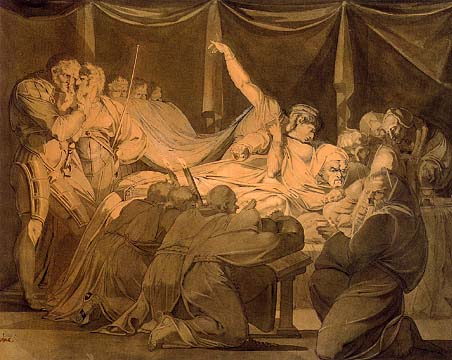
Pen and wash, approximately 25.5 x 33 inches. The Walker Art Gallery, Liverpool.

Pen and wash, approximately 25.5 x 33 inches. The Walker Art Gallery, Liverpool.
The source for this drawing is Henry VI, Part II (III.iii) where the Cardinal hallucinates, clutches the bed in terror, and bemoans his part in the death of Humphrey, Duke of Gloucester. The entire scene is just thirty lines:
CARDINAL
KING HENRY VI
WARWICK
CARDINAL
KING HENRY VI
WARWICK
SALISBURY
KING HENRY VI
WARWICK
KING HENRY VIKING HENRY VI
How fares my lord? speak, Beaufort, to thy sovereign.
If thou be'st death, I'll give thee England's treasure,
Enough to purchase such another island,
So thou wilt let me live, and feel no pain.
Ah, what a sign it is of evil life,
Where death's approach is seen so terrible!
Beaufort, it is thy sovereign speaks to thee.
Bring me unto my trial when you will.
Died he not in his bed? where should he die?
Can I make men live, whether they will or no?
O, torture me no more! I will confess.
Alive again? then show me where he is:
I'll give a thousand pound to look upon him.
He hath no eyes, the dust hath blinded them.
Comb down his hair; look, look! it stands upright,
Like lime-twigs set to catch my winged soul.
Give me some drink; and bid the apothecary
Bring the strong poison that I bought of him.
O thou eternal Mover of the heavens.
Look with a gentle eye upon this wretch!
O, beat away the busy meddling fiend
That lays strong siege unto this wretch's soul.
And from his bosom purge this black despair!
See, how the pangs of death do make him grin!
Disturb him not; let him pass peaceably.
Peace to his soul, if God's good pleasure be!
Lord cardinal, if thou think'st on heaven's bliss,
Hold up thy hand, make signal of thy hope.
He dies, and makes no sign. O God, forgive him!
So bad a death argues a monstrous life.
Forbear to judge, for we are sinners all.
Close up his eyes and draw the curtain close;
And let us all to meditation.
The drawing has all the drama we expect from Fuseli. The King points heavenward to the "mover of the heavens" and the Cardinal is contorted with guilt; "see," says Warwick, "how the pangs of death do make him grin." Fuseli did several versions of the scene, including book illustrations and a painting that was exhibited at the Royal Academy in 1808. The Cardinal's death was a popular subject for painters, and Sir Joshua Reynolds in the late 1780's chose the same scene to illustrate as Cardinal Beaufort's Bedchamber for the Boydell Shakespeare Gallery.
If the pictures of Fuseli and Reynolds seem somewhat similar it is because both allude to an earlier painting by Nicolas Poussin (1594-1665) entitled The Death of Germanicus. "None of the designs of Poussin has been more universally admired, than that of Germanicus," Fuseli once said, "and if he had never painted another picture he would have gained immortal honour by that alone" (quoted by Richard Verdi, Nicolas Poussin, 162). Fuseli's figures are more agitated and the composition more fluid than Poussin's, but the allusion to the earlier work, especially with the arm pointed upward and the general grouping of figures, pays homage to a painting Fuseli much admired. Reynolds chooses to include in his painting fewer figures than Poussin, but the debt is still obvious.